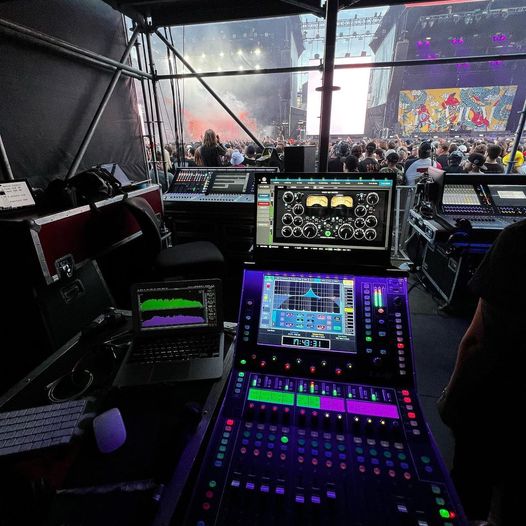
In this video from the Australian band Northlane, Dylan Mitrovich runs us through his FOH console set up, including outboard processing (Waves and Universal Audio), DSP and Qlab integrations.

Skip forward to time 4:30 for FOH, otherwise enjoy a brief walk-through of their drum set up.
Video Text
I’m Dylan I’m front of house for North Lane and uh today I’m going to show you through uh the front house rig that we’ve got set up which consists of the band’s Allen and Heath the live console uh and a bunch of other little bits and pieces that we have going on for processing so we’re effectively using the console as to mixing consoles for the band I run from the house uh further band out of the console but we also run all of the Bands uni monitors out of the rig as well so effectively we’ve got two sections of the console that are split one contains the
0:05:02.5 –>
challenge just between a house and then the other half contains the channels just for the uni monitors um and then the band will have control of that on stage through the iPad and that kind of stuff and I’ve built in different layers into the surface that allowed me to flick between whether it’s a front house layer or whether it’s in a monitor layer so uh in addition to what’s going on in the console I do have a lot of processing going on outside of that and primarily the digital transport that we’re using to do that is waves sound grid so it’s basically a low latency method of digital communication for audio and so uh signals come out of the console we’re using sound grid and then they go to two different paths if I’m using waves as the as a processing path so where I use Wave Super rack to house the waves plugins there’s also a wave sound grid serving inside the rack that processes does all of the DSP signal processing and then spits it back into the console for universal audio
0:06:01. –>
their live rack that I’ve got here actually uses Maddie as the transport protocol so also inside the rack there’s lot of things going on this tiny little rack there’s a digigrid MGO which converts that sound grid protocol to the Madi protocol which allows me to go through and process things on the uad platform and then spit it back into the console so mainly a lot of the subgroups are being processed through universal audio plugins and I’ve got 16 racks of plugins or up to 16 channels of plugins that I can run over parts of the console and you’ll see normally that I’m running generally some stuff over the keep group so the kick in and out are grouped together in their process same with the snare group Tom’s guitars a little bit of vocal processing mainly for kind of preamp use some of those really nice preamp emulations that uad have and then a master bus chain as well also runs through this
0:07:02.1 –>
so yeah bussing kind of in and out of the console into that in addition I run some Waves plugins for vocal processing and some kind of crazy effects like distortions and vicodas and those kinds of things really helped us Define and add some extra Dynamic to to Marcus’s vocals and then in addition you know some of the really handy tools that waves have such as PSE which primary source expander essentially acts as a little bit of a gate to filter out some of the on-stage sound from the drums and that kind of stuff to get a little bit more clarity out of out of the vocals and a little less spill in addition to that I do have a bit of um kind of automated processing going on in the background which I’m using qlab to do and what qlab will be doing is reading time code that the band sends into the console uh it waits for that signal once it receives the time code it’s going to spit out a bunch of cues
0:08:00.6 –>
to the console to change certain things that I’ve set up through the scenes window the kinds of things that I’m triggering here are things like delay on delay off um you know band level up and down you know automated vocal mutes and and Reverb mutes and those kinds of things so as an example as I start kind of firing some of these cues you’re likely to see you know some some faded movement and that kind of thing going on you know some of these cues will light up some of the touch screens and buttons and that kind of stuff that we have here and these things all fall out automatically as the as the band plays through the song just to take a little bit of the weight off the mix when I mix this band there’s quite a lot of things going on and moving around there’s a lot of dynamic throughout the songs that helps to take some of the brain power away from that so I can kind of focus on doing a lot of creative stuff the balancing that’s going on cool so that’s pretty much an overview of the Northland setup that we’ve been running with for this tour
Other Engineers
FOH Engineer Garry Brown (Phish, Trey Anastasio Band, Oysterhead)
Behind the Live Sound of Coldplay with Daniel Green
Red Hot Chili Peppers Sound Engineer – Dave Rat 2016 Set up
Antony King – Front of House Engineer for Depeche Mode
Gavin Tempany – FOH Tame Impala, Mark Knopfler, Hans Zimmer, Kylie and Eskimo Joe
Analogue vs Digital, How to ‘Hear’ when Mixing with Andrew Scheps
Matthew Walsh FOH Audio Engineer War on Drugs
